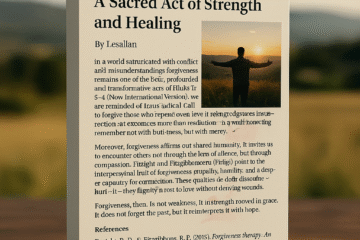Written by Lesallan – 03/30/2024
The Resurrection of Jesus in Matthew’s Gospel: A Beacon of Hope and Transformation

The Gospel of Matthew, one of the four canonical gospels in the New Testament, presents a profound narrative of Jesus’ resurrection in Matthew 28:1-10. At the heart of the Christian faith, this pivotal event symbolizes the triumph over sin, death, and the forces of darkness. It serves as a guiding light of hope and transformation for all believers.
The visit to the Tomb narrative begins with Mary Magdalene and the other Mary visiting the tomb where Jesus had been laid after His crucifixion. Their visit occurred after the Sabbath, as the first day of the week was dawning. This detail is significant as it marks the beginning of a new era, a new week, and a new life in Jesus’ resurrection.
Their visit was met with a tremendous earthquake, a clear sign of divine intervention, as an angel of the Lord descended from heaven, rolled back the stone covering the tomb entrance, and perched on it. The angel’s appearance was stunning, like a flash of lightning, and his clothing was as white as freshly fallen snow. These vivid descriptions underscore the divine nature of the event and the purity of the message being conveyed.
The guards at the tomb trembled and became like dead men due to fear. This reaction underscores the power and authority of God, which can cause even the most hardened hearts to tremble.
The angel addressed the women, reassuring them, “Do not be afraid, for I know that you seek Jesus who was crucified.” This statement acknowledges their faith and devotion to Jesus. The angel declared, “He is not here, for He has risen, as He said. Come, see the place where He lay.” This declaration encapsulates the essence of Christian faith – the resurrection of Jesus Christ.
The angel instructed them to go quickly and inform the disciples that Jesus had risen from the dead. Furthermore, the angel revealed that Jesus would meet them in Galilee. This instruction signifies the spread of the Good News and the continuation of Jesus’ ministry.
As the women left the tomb and encountered Jesus, they had a great sense of fear and great joy as they encountered Jesus Himself. Jesus greeted them, saying, “Greetings!” They approached Him, took hold of His feet, and worshiped Him. This encounter reaffirms the reality of Jesus’ resurrection and the appropriate response of worship.
Jesus reassured them, saying, “Do not be afraid; go and tell my brothers to go to Galilee, and there they will see me.” This reassurance calms their fears and commissions them to share the Good News with others.
The profound significance of this was that Jesus’ resurrection fulfilled His prophecy, providing a testament to His truthfulness. The empty tomb and the angel’s message bring hope and assurance to believers, affirming that death could not hold Jesus; He conquered it.
The women were entrusted with spreading the news, making them the first witnesses of the risen Christ. This commissioning highlights the vital role of women in the early Christian community.
The resurrection changed everything. It validated Jesus’ identity as the Son of God and the Savior of humanity. It transformed the lives of the disciples and continues to transform the lives of believers today.
So, Matthew’s account of the resurrection invites us to embrace the transformative power of Christ’s victory over death. It beckons us to encounter the risen Lord, just as Mary Magdalene and the other Mary did. The empty tomb echoes through history, proclaiming that Jesus is alive and His resurrection offers eternal hope to all who believe.
References:
[Matthew 28:1-10 ESV](https://www.biblegateway.com/passage/?search=matthew%2028:1-10&version=ESV)
[Jesus’ Death and Resurrection (Matthew 27-28) – Theology of Work](https://www.theologyofwork.org/new-testament/matthew/jesus-death-and-resurrection-matthew-27-28)


